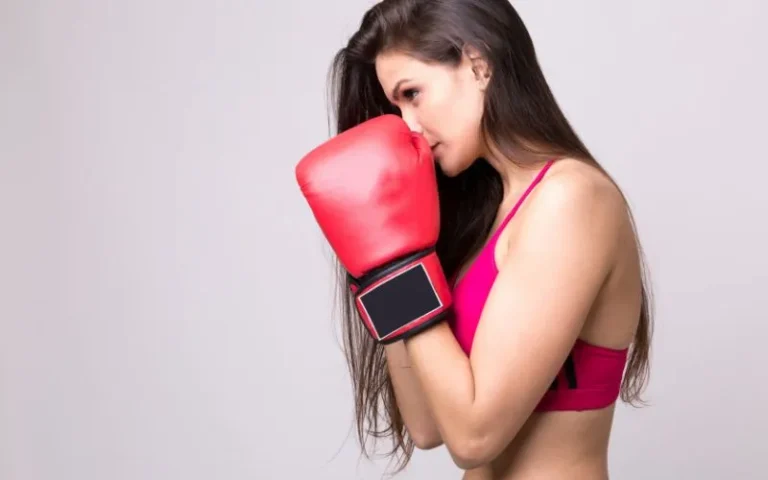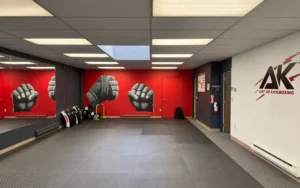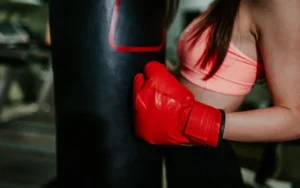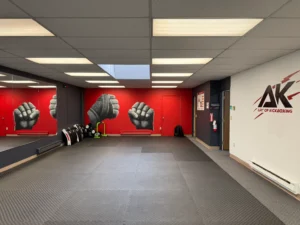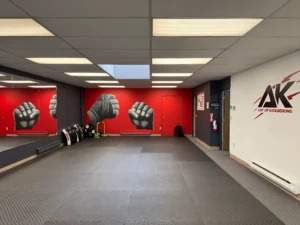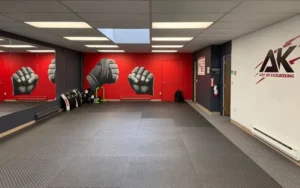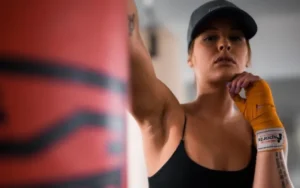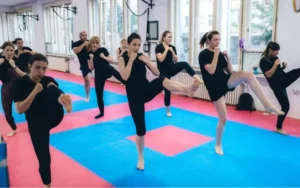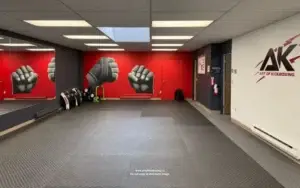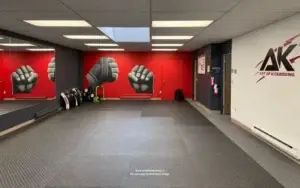Boxing moves for beginners start from learning the stance, footwork, and the jab before moving onto more advanced boxing techniques. Boxing gyms that actually teaches proper techniques in Vancouver should follow a structured method, at least for beginning lessons, like Art of Kickboxing does.
Students typically begin with movement skills, core boxing punches, and then basic combinations, all of which build muscle memory for safe, effective progress.
Here’s a list of beginner boxing moves for beginners, that you’ll learn taking boxing lessons at Art of Kickboxing, and what they’re used for, including both punches and defensive techniques.
Reading these descriptions and practicing them isn’t sufficient to actually learning boxing, as it doesn’t have the component of dealing with another human, that’s why Art of Kickboxing provides boxing classes and private boxing lessons in Metro Vancouver for those interested.
Boxing Moves for Beginners & What They’re Used For: Punches & Defensive Techniques
Six Basic Boxing Punches
In boxing, “lead” refers to the hand and foot positioned closest to the opponent, while “rear” refers to the hand and foot positioned farther back for power generation.
For an orthodox fighter, the lead side is the left hand and left foot while the rear side is the right hand and right foot, and for a southpaw fighter this is reversed, with the lead being the right side and the rear being the left, shaping how each stance generates angles, reaches, and power.
1. Jab (Lead Hand Punch, “1”)
A straight punch from the lead hand, executed quickly with minimal rotation. In the punch number system, it is the “1.”
What It’s Used For:
- Controls distance
- Sets up the jab-cross combo
- Disrupts an opponent’s rhythm
- Feints
2. Cross (Straight, Rear Straight, “2”)
A straight punch thrown from the rear hand with full hip rotation.
What It’s Used For:
- Primary power shot after the jab
- Central to beginner combinations
- Clean scoring punches
3. Lead Hook (Left Hook, “3”)
A bent-arm punch thrown horizontally from the lead side.
What It’s Used For:
- Targets the head or body
- Complements body shots to the ribs or solar plexus
4. Rear Hook (Right Hook, “4”)
A rear-side hook delivered with full torso rotation.
What It’s Used For:
- Used when an opponent moves into the rear-side angle
- A powerful alternative to the right uppercut
5. Lead Hand Uppercut (Left Uppercut, “5”)
An upward punch from the lead hand, rising between the opponent’s gloves.
What It’s Used For:
- Counters forward pressure
- Opens opportunities for follow-up hooks
6. Rear-hand Uppercut (Right Uppercut, “6”)
A vertical punch from the rear hand.
What It’s Used For:
- Delivered at close range for maximum stopping power
- Effective against opponents who dip forward
Six Basic Boxing Moves
1. Slip
A small head movement off the centerline.
What It’s Used For:
- Avoids straight punches
- Prepares students for more advanced defensive techniques like the shoulder roll
2. Roll (Duck, Under)
A bending movement under wide punches such as hooks.
What It’s Used For:
- Creates counterpunching angles
- Forms the base mechanics for a beginner-friendly version of the “Dempsey Roll”
3. Parry
A redirection using the hands.
What It’s Used For:
- Disrupts incoming strikes with minimal effort
- Sets up immediate counters
4. Pivot
A sharp rotation on the lead foot.
What It’s Used For:
- Creates angles
- Evades pressure
- Improves ring control—useful even during ceremonial moments like a ring entrance
5. Shuffle
Small, controlled steps that maintain stance.
What It’s Used For:
- Adjusts distance
- Keeps balance during offensive and defensive transitions
6. Block
A protective action using the arms and gloves.
What It’s Used For:
Forms the foundation of defence techniques, including advanced structured systems like the “Peek-a-Boo Defence.”
3 Boxing Combinations for Beginners
1. Jab, Cross (1-2)
A straight lead hand punch followed by a straight rear hand punch.
What It’s Used For:
- Teaches rhythm, mechanics, and timing—important for clean boxing punches.
2. Jab, Jab, Cross (1-1-2)
Two jabs to draw reactions, then a cross.
What It’s Used For:
- Builds pressure
- Forces defensive mistakes from the opponent
3. Jab, Cross, Hook (1-2-3)
Two straight punches followed by a hook.
What It’s Used For:
- Introduces angle changes
- Transitions between linear and circular strikes
7 Boxing Terms for Beginners
1. Orthodox Stance
Left foot and left hand forward.
What It’s Used For:
- Default stance for most right-handed athletes
2. Southpaw Stance
Right foot and right hand forward.
What It’s Used For:
- Default stance for most left-handed athletes
- Creates opposite-stance strategies
- Creates unique angles
3. Guard
Hand and arm position protecting head and body.
What It’s Used For:
- Baseline defensive structure for all beginners
4. Footwork
Movement patterns that maintain balance and angle.
What It’s Used For:
- Affects distance, timing, and pressure management
5. Lead Foot / Rear Foot
The forward foot (lead foot) and the back foot (rear foot) in stance.
What It’s Used For:
- Controls mobility, stability, and power generation.
6. Distance / Range
The spacing between two fighters.
What It’s Used For:
- Determines safe striking opportunities and defensive responses
7. Feint
A deceptive action meant to draw a reaction.
What It’s Used For:
- Creates openings for combinations or counters.
Learn Boxing Techniques at Art of Kickboxing in Metro Vancouver
A structured progression is the most reliable way for beginners to develop real proficiency in boxing, and these fundamental punches, movements, and terms form the base of every skill that follows.
Understanding how stance, footwork, and core techniques work together is essential, but applying them against a live partner is what transforms theory into practical ability. This is why beginners benefit from a boxing gym that actually teaches proper techniques in Vancouver from day one.
Art of Kickboxing provides this environment through guided boxing classes and private lessons in Metro Vancouver, ensuring that every student learns correct technique, gains confidence, and builds lasting self-defence skills that lead naturally into more advanced boxing development. Try a free trial class today!

